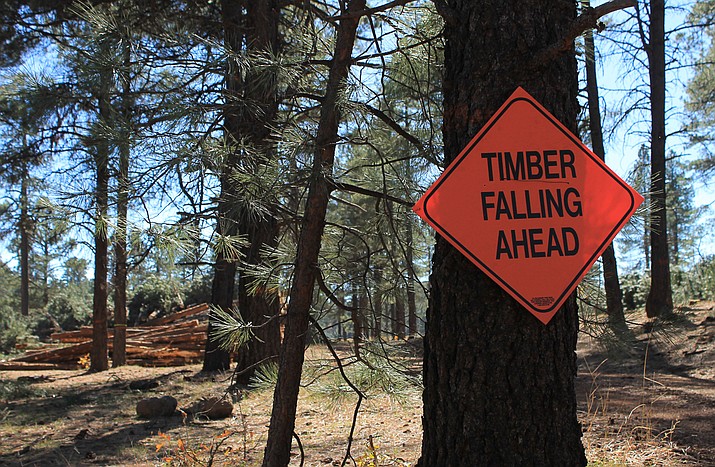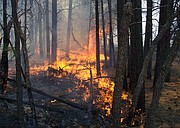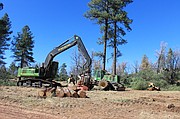Treatment continues on Kaibab despite slow 4FRI progress
Despite slow progress with 4FRI on the western portion of the project, Kaibab National Forest continues forest restoration efforts through other timber sales and stewardship contracts.
In 2009, an out of control wildfire that led to the evacuation of 64 residences along with closures of schools, businesses and streets on the western edge of Williams, was a wake-up call to the town’s 3,500 residents.
Labelled the Twin Fire, the fire began as a U.S. Forest Service prescribed burn and catapulted into a wildfire because of high winds and dry vegetation. The fire required approximately 500 on the ground personnel and several air tankers to extinguish, and cost taxpayers close to $3 million.
In response to this fire and fires like the 2002 Rodeo-Chediski Fire in the White Mountains that burned 468,638 acres, destroying 465 homes, and the 2011 Wallow Fire that burned 538,000 acres and 72 buildings, the U.S. Forest Service launched the Four Forest Restorative Initiative (4FRI) in 2012 to restore 2.4 million acres of forest ecosystems in 20 years on portions of four National Forests — Coconino, Kaibab, Apache-Sitgreaves and Tonto — along the Mogollon Rim in northern Arizona.
The project was designed to not only reduce high intensity wildfires, but to restore watersheds, improve wildlife habitat, conserve biodiversity, protect old-growth and make the forest more resilient to climate change.
The first phase of the project delineated 600,000 acres of land on Coconino and Kaibab National Forests for treatment utilizing mechanical thinning, prescribed fire and other tools for restoration. The plan was for 30,000 acres to be treated per year.
In 2012, Pioneer Forest Products was selected as the contractor to perform treatments on the forests with plans to build a plant near Winslow, Arizona, where the timber would be converted into high value lumber, laminate wood panels, window frames and cabinetry.
In 2013, Pioneer, after failing to finance a mill or ramp up cutting in its first 16 months on the job, obtained USFS approval to transfer the contract to Good Earth Power.
Since the transfer of the contract, Good Earth Power has struggled to fulfill the 4FRI restoration goal originally envisioned and has been subject to several lawsuits from partners, subcontractors and former employees for fraud, breach of contract and failure to pay wages.
So far, Good Earth Power has thinned just a fraction of the acreage the Forest Service made available to the company.
As of March, according to Forest Service statistics, just 8,332 total acres had been treated under the Phase 1 contract after five years and the total acres treated is nowhere near the 150,000 acres the Forest Service envisioned having treated by now.
Lack of industry
In addition to the apparent internal struggles at Good Earth, the western side of 4FRI is limited in industry, which has slowed the treatment process.
According to Scott Russell, the Forest Service’s chief officer of the 4FRI project, finding a buyer for the small diameter trees and biomass — treetops, needles and branches — has been difficult on the west side.
“Right now there’s just no place to take it and that is the problem that every contractor out there is struggling with,” said 4FRI Public Affairs Specialist Brienne Pettit. “It (the timber and biomass) starts to lose its value literally as they’re driving down the road.”
Eastern Arizona success
Despite the dire situation on the western side of the 4FRI footprint, steady progress has been made on forests on the eastern side of Arizona.
“We’ve got about 15,000 acres that is being done annually there,” Russell said. “That is the story of more industry on the east side.”
Russell said timber harvesters on the eastern side of 4FRI can utilize the small diameter trees and biomass in industry. He said Novel Energy takes the biomass and generates power from it, and Forest Energy can use smaller diameter materials for pellets.
A new vision
Learning from the problems with the Phase 1 contract with Good Earth, Russell presented a new plan to jumpstart forest treatment on the western side of 4FRI at the March stakeholders meeting.
The new plan is being called Vision 17 and addresses how the implementation of the first EIS can move forward and be successful.
Russell said the Forest Service is working toward another Request for Proposals (RFP) that would be another large contract like what was offered to Good Earth. The Forest Service will be looking for new ideas to thin trees and remove biomass with the objective of creating and developing sustainable industries.
“We will be soliciting proposals from people to do that work,” he said.
Large amounts of acreage are necessary to facilitate industry investment into the area, Pettit said.
“Somebody needs to be guaranteed that much product for them to get the investment they need and the money they need to even put the market in place,” she said.
Russell said forest managers are in the early stages of working on that RFP.
“We are trying to learn from what we did last time and figuring out how to do that better,” he said.
Russell said the required environmental analyses are done and the acreage is ready for mechanical thinning. With the completed analysis, Russell is hoping to attract interested investors by this fall.
He said one difference in the new contract would be performance requirements and guarantees that were not put into the Phase 1 contract with Good Earth.
Bill Williams Mountain
Despite the slow progress with 4FRI on the western side, the Forest Service is moving forward with individual timber sales and stewardship contracts on the Kaibab, especially on and around Bill Williams Mountain.
Long known to be a potential tinderbox to the city of Williams, forest restoration on the mountain became a priority to forest and city officials after the Twin Fire in 2009.
After much discussion, in 2011, Kaibab National Forest submitted a proposal to treat 15,200 acres on the mountain.
After four years of planning and public comment, the Final Record of Decision for the Bill Williams Mountain Restoration Project was signed in December 2015 at the Williams Ranger District.
The approved plan allowed forest workers to begin restorative treatments including thinning and burning in the overgrown forest on Bill Williams Mountain in Kaibab National Forest.
Forest managers said the Bill Williams Mountain Restoration Project was set aside because of its unique features and proximity to Williams.
“The consensus early on with 4FRI was to limit the scope of that analysis and work to slopes under 40 percent,” said Timber Management Officer for the Williams and Tusayan Ranger Districts Micah Grondin during the signing. “The challenge of those slopes and different conditions really warranted a specific look at how to treat it.”
Forest managers agree that a massive forest fire on Bill Williams would affect air quality, the watershed, the city reservoirs, communication towers, fire fighter safety, historical and cultural sites and a fragile mountain ecosystem.
The project currently has three timber sales in progress that include the Coyote, Devil and Clover areas. Thinning is also in progress on the south side of Bill Williams and will continue through the summer.
“These projects will reduce tree densities and ladder fuels which assist in keeping wildfires from burning into the tops of the trees and moving from tree to tree, known as a crown fire,” said Williams Ranger District Assistant Fuels Management Officer Mike Uebel.
Uebel said thinning will continue to move west throughout the fall and early winter in the Bixler Saddle area.
Restoration of Aspen trees is also a component of the project which will begin this summer.
“This will create conditions to promote a healthier aspen stand by reducing competing conifer trees and allowing for new growth,” Uebel said.
Uebel said the Kaibab is also in the process of assessing fuels reduction operations on the steep slopes of the mountain, developing a plan of operation and seeking funding for implementation.
Some are concerned about the remaining untreated acreage not associated with the Bill Williams Mountain project that surrounds Williams and also has a high potential for a repeat wildfire.
Many of those acres are tied up with the Phase 1 contract awarded to Good Earth and harvester James Perkins of Perkins Timber Harvesting is hoping to negotiate an agreement to treat the acres himself.
“This is my home and I don’t want to see it burn down,” Perkins said.
- Driver identified in fatal accident on Perkinsville Road Sept. 19
- Latest Tik Tok challenges causing problems for Williams Unified School District
- Search at Grand Canyon turns up remains of person missing since 2015
- Plane wreckage and human remains found in Grand Canyon National Park
- Pumpkin Patch Train departs Williams starting Oct. 5
- Update: Man missing in Grand Canyon National Park hike found alive
- Receding water levels at Lake Powell reveal missing car and driver
- Man sentenced for attack on camper at Perkinsville
- Column: Lumber prices expected to stay high through 2022
- Elk rut season in Grand Canyon: What you need to know
SUBMIT FEEDBACK
Click Below to:








